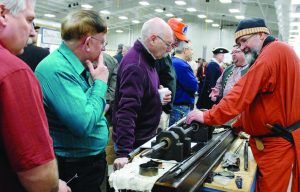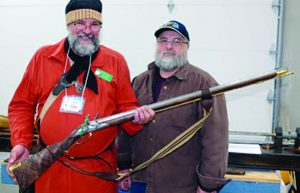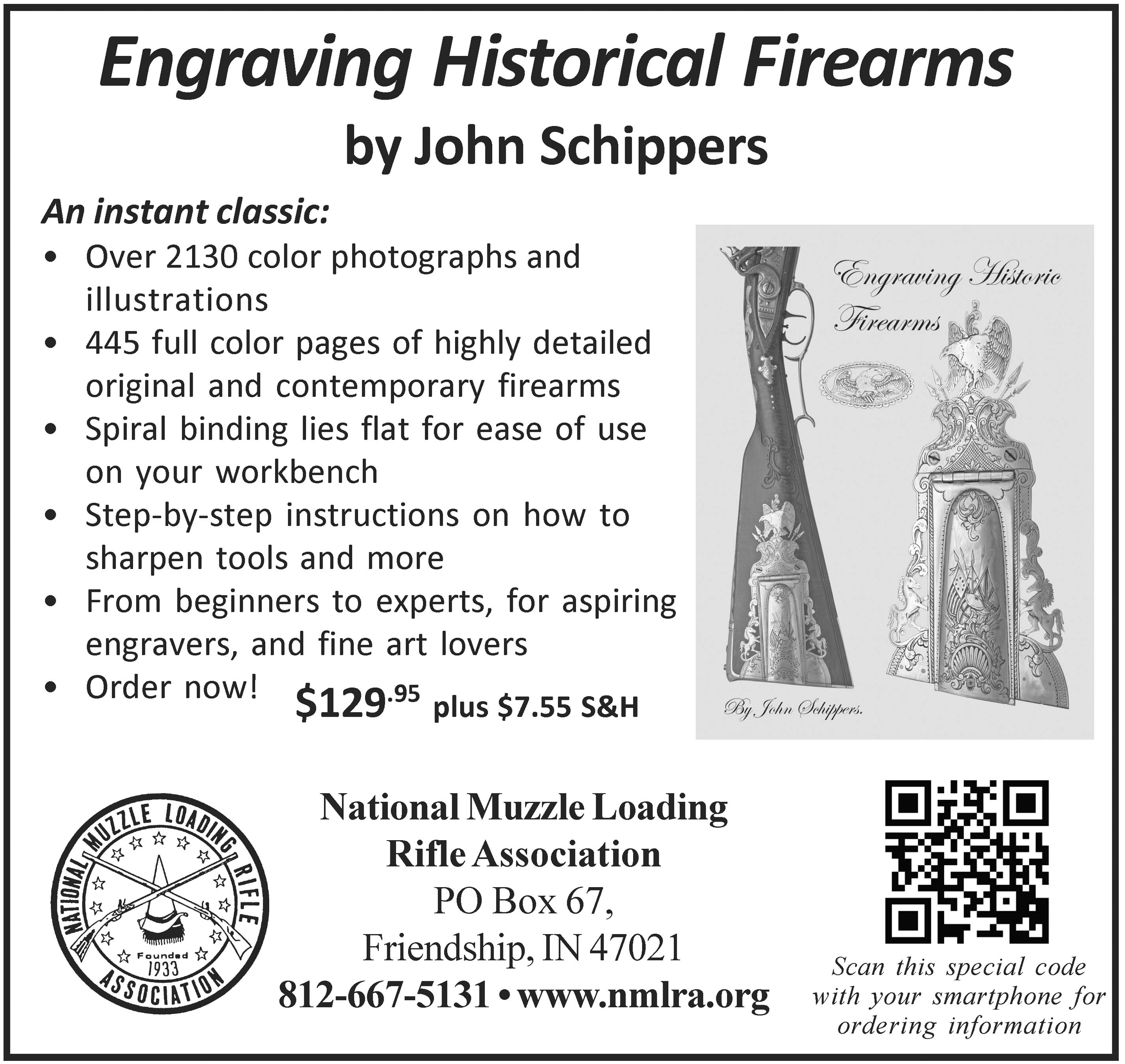by James C. Fulmer | Past President, NMLRA
When Ron Greene built his personal rifling machine I am sure he had no idea of the legacy it would bring to muzzleloading. Greene was born March 10, 1939, and passed from this life into the next December 6, 1994. I first met Ron at Dixon’s Gunmakers Fair in Pennsylvania many years ago. He had made a simple “box” rifling machine and was demonstrating how 18th century rifle barrels had the groves cut in them.
Ron had a lifelong passion of showing the public how a smoothbore barrel, which was only accurate to about 80 yards, could be replaced with a rifled barrel that, shooting a patched round ball, could be accurate at over 200 yards. Ron, with just this machine sparked interest in not only rifling and the history, but in firearm shooting in general.

Standing on the right is the author in red with Chris Gergeni, NMLRA managing director, at the working end of the rifling machine talking to a group at Kalamazoo, MI. (Photo by Becky Waterman)
Ron’s wife Joan presented a working model of an 18th century rifling machine to the National Muzzle Loading Rifle Association. The rifling machine was the third one he built.
All three machines are still being used to give demonstrations around the country. The one at the Dixon’s Gunmakers Fair is well known. The last full weekend in July you will find two brothers, Paul and Mel Hartranft, busy demonstrating. They are two of the finest craftsmen I know who rifle barrels the old 18th-century way.
The machine that the NMLRA received was Ron’s personal machine. When you see the machine in action it will probably have a one-turn-in-60-inch wood mandrel, giving a slow spin to a round ball, which is about perfect for most calibers. The machine also can cut either seven or eight groove rifling.
Rifling was believed to have started in the 1500s. No one is quite sure how the rifle barrel got started. The importance of spinning an arrow for accuracy was developed long before firearms where invented. The arrows would be made to spin by either a spiraled point or by the fletching on the shaft. So if it worked for arrows for greater accuracy and distance, what would it take to make a ball spin? I don’t know how or why it was done, but I am sure the first time it was cut and the patched ball spun out of the barrel it was the most accurate firearm of the day.
A patched round ball, as a projectile, can be forgiving. I have seen muzzleloading barrels shoot excellently with groves .005 deep to .015 deep. However, .008 to .010 seems to work the best for me when I am rifling. You want the grooves deep enough to grip the cloth patch around the round ball, but not too deep that it lets the hot gases from the burning powder force a way around the patch and ball through the grooves. If your patch doesn’t grip the rifling or doesn’t seal your bore it will throw off your accuracy.
Every barrel maker has their own theory on what makes a muzzleloading rifle barrel shoot great. One is the width of the lands (the inside bore) or the groove (deepest part in a barrel). I have seen narrow lands and wide grooves shoot great along with wide lands and narrow groves. I have also seen combinations that try your patience to make them shoot. I have never seen the same size lands and the same size grooves shoot badly with a patched round ball.
The number of lands and grooves doesn’t seem to matter that much. I have seen six, seven, and eight grooved barrels all shoot well.
Rate of twist for smaller caliber rifles shooting a patched round ball is usually around is one revolution in 48”; and one turn in 60” for larger bore rifles.
Ron Greene’s rifling machine is well traveled. This year it started with a new barrel in Michigan at the Kalamazoo Living History Show in March. In April it was at the Field & Stream Store in Altoona, PA. Then it went to Carlisle, PA, at the Army Heritage Center in May. It may show up anywhere in July and August, but will be at Ft. Roberdeau for the October Trade Faire and Rifle Frolic, where the barrel will be finished.

The author, left, and Buddy Townsend who just finished a .54 cal. rifle from a barrel made during the previous year. (Photo by Becky Waterman)
People ask me how long it takes to rifle a barrel. I tell them the barrel is in the machine about eight months, but you can actually rifle it with two people in 10 to 12 hours. The rifling machine is the perfect vehicle to stop people at shows and get them talking about the history of rifles, the birth of the Pennsylvania long rifle, muzzleloading hunting, target shooting, the NMLRA, and almost anything to get people interested in the muzzleloading sport. That is how 10 or 12 hours turns into 8 months. The barrels made on this machine have been auctioned, built into muzzleloaders and raffled off, and given away as prizes. This year’s raffle prize is to benefit the NMLRA Rifle Frolic at Altoona Rifle and Pistol Club during the 18th Century Market Faire and Rifle Frolic at Ft. Roberdeau.
In this day and age, we all need to be talking, and taking any opportunity we have to speak about our shooting sport. We are the only ones who can promote muzzleloading or our love of the 2nd Amendment. Because of our enthusiasm and our passion for this topic, we must be prepared to engage people, to listen to them, and talk to them about what we love. I am constantly invited to speak about the history of firearms in the American Revolution. This gives me an opportunity to also talk about the 2nd Amendment; about how important it was when our country was founded, and how important it is now. Many times I will get asked to give a 20 to 30 minute talk about muzzleloader hunting and target shooting. I very seldom turn down an opportunity to speak and promote my sport.
You also need to be promoting the shooting sports as well. It’s not hard. If you shoot 3-gun, trap, skeet, high power—whatever you do that involves a shooting discipline—always remind the people of the origin and the need for the 2nd Amendment. Talking about something you love will come easy and your enthusiasm will show through.




